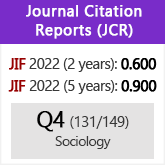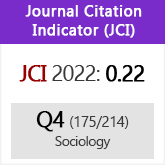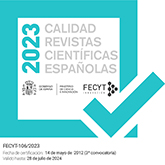Ideal family model in spanish society
DOI:
https://doi.org/10.3989/ris.2006.i43.43Keywords:
Family Relationships, Individual Preferences, Gender Roles, Segmentation AnalysisAbstract
The aim of this article is to study the ideal models of family relationships in Spain. To this end, we start analysing the roles and responsibilities of the couple, both in the labour and the domestic spheres. The strategy of analysis consists of two phases. First, we analize the Spanish population preferences regarding the most preferred type of family (ideal family model). In addition, we observe the evolution of these opinions over the last few years. In the second phase considered as the focal point of our study, we deepen the analysis on the ideal family models. Furthermore, we state the most influential socio-demographic variables in relation to the ‘symmetrical or egalitarian’ ideal model, which is considered to be the one in which both man and woman have a formal job and share housework and childcare.
Downloads
References
Alberdi, I. (2003), “El trabajo remunerado de las mujeres y su impacto en la vida familiar”, Arbor, nº 694, Tomo CLXXVI.
Beck, U. y E. Beck-Gernsheim (2003), La individualización. El individualismo institucionalizado y sus consecuencias sociales y políticas, Barcelona, Paidós.
Del Campo Urbano, S. (2003), “Familia tradicional y estado de bienestar en Europa”, Arbor, nº 694, Tomo CLXXVI.
Díaz, C. (1997), “El futuro familiar en la España de los noventa”, Revista de Estudios de Juventud, nº 39, pp. 107-117.
Duncan, S. et al. (2002), Analysing Families: Morality and Rationality in Policy and Practice, Londres, Routledge.
Durán, M. ª A. (2001), “Uso del espacio y relaciones familiares”, Escuela de Sociología de la Familia “Enrique Gómez Arboleya”, UIMP, Santander.
Escobar, M. (1992), ”El análisis de segmentación: concepto y aplicaciones”, Working Paper, nº 31, Madrid, Instituto Juan March de Estudios e Investigaciones.
Esping-Andersen, G. (1990), The Three Worlds of Welfare Capitalism, Cambridge, Polity Press.
Esping-Andersen, G. (1999), Social Foundations of Postindustrial Economier, Oxford, Oxford University Press.
Esping-Andersen, G. (2002), “A New Gender Contract” en Esping-Andersen et al. (eds.), Why We Need a New Welfare State, Oxford, Oxford University Press.
Eurostat (1990 y 2000), Encuesta de fuerza de trabajo, Luxemburgo, Comisión Europea.
Ferrera, M. (1996), “The ‘Southern’ Model of Welfare in Social Europe”, Journal of European Social Policy, Vol. 6, pp. 17-36. doi:10.1177/095892879600600102
Flaquer, L. (1995), “El modelo de familia española en el contexto europeo”, en S. Sarasa y L. Moreno (eds.), El Estado de Bienestar en la Europa del Sur, Madrid, CSIC, pp. 9-59.
Gifi, A. (1990), Nonlinear Multivariate Analysis, Chichester, Wiley.
Hakim, C. (2000), Work-lifestyle choices in the 21st Century: Preference theory, Oxford, Oxford University Press.
Hakim, C. (2003), Models of the family in modern societies: Ideals and realities, Londres, Ashgate.
Hakim, C. (2003), “The polarisation of lifestyles in Britain and Spain”, Sixth European Conference on Sociology, Universidad de Murcia, España.
Lewis, J. (1992), “Gender and the Development of Welfare Regimes”, Journal of European Social Policy, Vols. 2 y 3, pp. 159-173.
Miller, L. M. (2004), “Participación laboral femenina y Estados de bienestar”, REIS, nº 108, pp. 49-74.
Moreno, L. (1997), “The Spanish development of Southern Welfare”, Documento de Trabajo/Working Paper, Instituto de Estudios Sociales de Andalucía.
Moreno, L. (1999), “La vía media española del régimen de bienestar mediterráneo”, Documento de Trabajo, Madrid, Unidad de Políticas Comparadas.
Moreno, L. (2000), Ciudadanos precarios. La “última red” de protección social, Barcelona, Ariel.
Naldini, M. (2003), The Family in the Mediterranean Welfare States, Londres, Frank Cass.
Navarro, L. (2003), “Estrategias de compatibilización entre la vida familiar y la vida laboral del hombre y de la mujer en el trabajo remunerado: roles de la mujer”, Sixth European Conference on Sociology, Universidad de Murcía, España.
Otsner, I. (1994), “The Women and Welfare Debate”, en L. Hantrais, y S. Morgan. (eds.), Family Policy and the Welfare of Women. Cross-National Research Papers, Third Series, 3. European Research Centre, Universidad de Loughborough.
Sarraceno, C. (1995), “Familismo ambivalente y clientelismo categórico en el Estado de Bienestar italiano”, en S. Sarasa y L. Moreno (eds.), El Estado de Bienestar en la Europa del Sur, Madrid, Consejo Superior de Investigaciones Científicas, pp. 261-288.
Sarasa, S. y L. Moreno (1995), El Estado de Bienestar en la Europa del Sur, Madrid, Consejo Superior de Investigaciones Científicas.
Titmuss, R. M. (1973), Choice and ‘the Welfare State’. Commitment to Welfare, Londres, Allen & Unwin.
Tobío, C. (2005), Madres que Trabajan, Dilemas y Estrategias, Madrid, Cátedra.
Vogel, J. (1997), “The European Welfare Mix: Institutional Configuration and Distributive Outcomes in Sweden and the European Union. A longitudinal and Comparative Perspective”, Conference International Society for Quality of Life Studies, Charlotte, N.C., USA 20-23, November, 1997.
Walby, S. (1990), Theorizing Patriarchy, Oxford, Blackwell.
Wilensky, H.L. y C. N. Lebaux (1965), Industrial Society and Social Welfare, Nueva York, Russell Sage Foundation.
Downloads
Published
How to Cite
Issue
Section
License
Copyright (c) 2006 Consejo Superior de Investigaciones Científicas (CSIC)

This work is licensed under a Creative Commons Attribution 4.0 International License.
© CSIC. Manuscripts published in both the printed and online versions of this Journal are the property of Consejo Superior de Investigaciones Científicas, and quoting this source is a requirement for any partial or full reproduction.All contents of this electronic edition, except where otherwise noted, are distributed under a “Creative Commons Attribution 4.0 International” (CC BY 4.0) License. You may read here the basic information and the legal text of the license. The indication of the CC BY 4.0 License must be expressly stated in this way when necessary.
Self-archiving in repositories, personal webpages or similar, of any version other than the published by the Editor, is not allowed.

















